Video of the Week:
Water-Wise Way to Irrigate Trees
Turfgrass:
Grub Control in Lawns
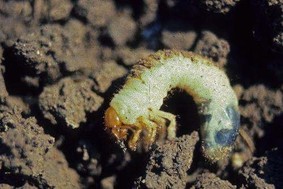
Traditional grub insecticides such as Dylox or carbaryl (Sevin) are normally applied in late July after grubs are present or as a rescue treatment once damage is seen. Products that contain Merit (imidacloprid) are considered grub preventers. Actually, these products do not prevent grubs, but rather kill grubs when they are quite small, and long before they cause damage. Merit is safer to use around pets and humans than traditional grub killers. Merit can be found in Bayer's Season-Long Grub Control, Grub No-More and Grub Free Zone.
Another grub preventer with the trade name GrubEx contains chlorantraniliprole. Though this product is very effective, it is less water soluble than imidacloprid. It should be applied earlier, preferably April or May, but applications through June should still be effective. Remember, all grub products should be watered in soon after application. (Ward Upham)
Vegetables:
Tomato Leaf-Spot Diseases
Septoria leaf spot usually appears earlier in the season than early blight and produces small dark spots. Spots made by early blight are much larger and often have a distorted “target” pattern of concentric circles. Heavily infected leaves eventually turn yellow and drop. Older leaves are more susceptible than younger ones, so these diseases often start at the bottom of the plant and work up.
Mulching, caging, or staking keeps plants off the ground, making them less vulnerable. Better air circulation allows foliage to dry quicker than in plants allowed to sprawl. Mulching also helps prevent water from splashing and carrying disease spores to the plant.
In situations where these diseases have been a problem in the past, rotation is a good strategy. It is too late for that now, but keep it in mind for next year. Actually, rotation is a good idea even if you have not had problems in the past. But many gardens are too small to make it practical. If you have room, rotate the location of the tomatoes each year to an area that has not had tomatoes or related crops (peppers, potatoes, eggplant) for several years.
If rotation is not feasible, fungicides are often helpful. Be sure to cover both upper and lower leaf surfaces, and reapply fungicide if rainfall removes it. Plants usually become susceptible when the tomato fruit is about the size of a walnut. Chlorothalonil is a good choice for fruiting plants because it has a 0-day waiting period, meaning that fruit can be harvested once the spray is dry. Chlorothalonil can be found in numerous products including Fertilome Broad-Spectrum Landscape and Garden Fungicide, Ortho Garden Disease Control, GardenTech Daconil and others. Be sure to start protecting plants when the disease is first seen. It is virtually impossible to control this disease on heavily infected plants.
If chlorothalonil doesn’t seem to be effective, try mancozeb (Bonide Mancozeb Flowable). Note that there is a five-day waiting period between application and when the fruit can be harvested. You may wish to pick some tomatoes green just before you spray if you use Mancozeb as the tomato fruit will ripen inside. (Ward Upham)
Pests:
Squash Bugs
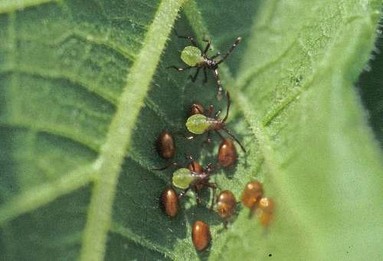
Because squash bugs feed by sucking juice from the plant, only insecticides that directly contact the insect will work. General use insecticides such as permethrin (Bug-B-Gon Multi-Purpose Garden Dust, Green Thumb Multipurpose Garden and Pet Dust, Bug-No-More Yard and Garden Insect Spray, Eight Vegetable, Fruit and Flower Concentrate, Garden, Pet and Livestock Insect Control, Lawn & Garden Insect Killer), malathion, and methoxychlor provide control if a direct application is made to young, soft-bodied squash bugs. This means that you MUST spray or dust the underside of the leaves because this is where the insects live. (Ward Upham)
Euonymus Scale
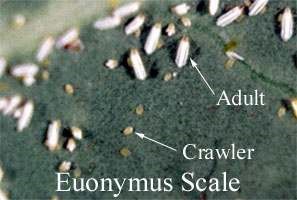
The first generation occurs in the spring. Overwintering females lay eggs that hatch in late May or early June. This period usually occurs when fringetrees, (Chionanthus), cockspur hawthorn (Crataequs crusgalli), Beautybush (Kolkwitzia amabilis) and Late Lilac (Syringa villosa) are in bloom. Crawlers move to leaves and stem and begin to feed by sucking plant juices. Maturing males prefer leaves and females congregate on stems.
We are too late for control of crawlers for the first generation as this spray should coincide with early bloom of catalpa. Full bloom of catalpa was on May 20 in the Manhattan area this year.
The second generation normally appears in late August to early September. Check to be sure crawlers are present before treating. Use a magnifying lens to identify the very small crawlers. If nothing is moving, crawlers are not active yet.
Labeled insecticides include malathion and acephate (Hi-Yield Acephate or Ortho Systemic Insect Killer), permethrin (Hi-Yield 38 Plus Turf Termite and Ornamental Insect Control, Hi-Yield Indoor/Outdoor Broad Use Insecticide and Lawn & Garden Insect Killer, Fertilome Indoor\Outdoor Multi-Purpose Insect Spray) or cyhalothrin (Spectracide Triazicide, Bonide Caterpillar Killer).
Control is probably impossible for euonymus that has been heavily attacked and is in very poor health. Therefore, complete removal and destruction of the infested plants (including roots) is suggested. (Ward Upham)
Japanese Beetles
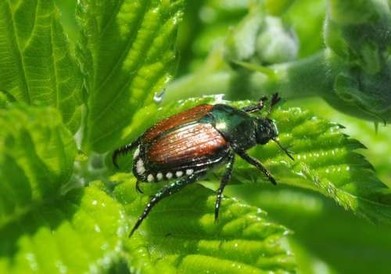
Japanese beetles tend to be gregarious and feed in groups, starting at the top of a plant and working down. Warm, sunny weather is preferred with beetles favoring plants in full sun. When disturbed, adults fold their legs and drop from foliage. Adult beetles can be killed by shaking the beetles from the plant into a jar or bucket containing soapy water. This is best done in the morning when the insects are sluggish.
Numerous insecticides can be used including pyrethroid products such as cyfluthrin (Tempo, Bayer Vegetable & Garden Insect Spray), bifenthrin (Hi-Yield Bug Blaster II) and cyhalothrin (Bonide Beetle Killer, Spectracide Bug Stop Indoor + Outdoor Insect Killer, Spectracide Triazicide, Bonide Caterpillar Killer). Carbaryl (Sevin) can also be used. The pyrethroid products normally give 2 to 3 weeks protection with carbaryl not lasting as long; usually 1 to 2 weeks. All of the above insecticides are detrimental to natural controls such a parasitoids and predators or other pests including the two-spotted spider mite. Neem products (Natural Guard Neem-Py, Fertilome Triple Action Plus) and Pyola (pyrethrins in canola oil) will provide deterrence for 3 to 4 days. Japanese beetle traps tend to attract more beetles than they kill and often do more harm than good and therefore are not recommended. (Ward Upham)
Ornamentals:
Leaf Scorch on Trees
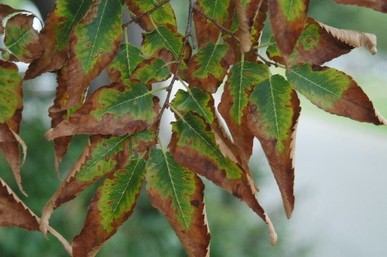
Scorched leaves turn brown or, in some cases, turn black from the edges and between the major veins. If severe, the leaf may drop. Leaves may be affected over the entire tree or may be affected only on one side. White pines are also prone to this condition due to the delicacy of the needles.
Though scorch can be due solely to the weather, the condition of the roots of plants can make them much more susceptible to this condition. Shallow soils such as those over hardpan or rock lead to a limited root system that may not be able to absorb all the water needed. Trees may be more sensitive to scorch this year because of the heavy rains many areas received this spring. In many cases so much rain was received that oxygen was driven from the soil resulting in root damage. That root damage is now making it more difficult for trees to provide all the water needed for the leaves. Also, root damage due to disease, insects, poor drainage or construction can cause poor water uptake.
To help alleviate damage due to dry soils or limited root systems, water once per week for recently transplanted trees of every two weeks for large trees if there is no rainfall. Mulching small trees or shrubs will help conserve moisture. (Ward Upham)
Inexpensive Method of Watering Trees
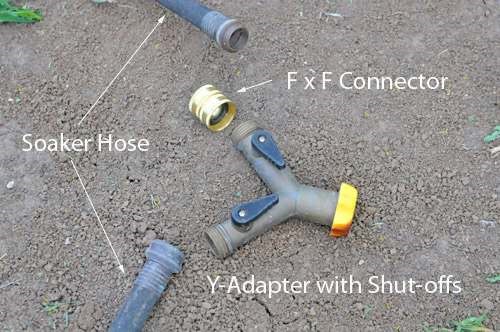
Soaker hoses are notorious for non-uniform watering. In other words, you often receive too much water from one part of the hose and not enough from another. Hooking both the beginning and the end of the soaker hose to a Y-adapter helps equalize the pressure and therefore provide a more uniform watering. The specific parts you need are shown in the photo above and include the soaker hose, Y-adapter and female to female connector.
It is also helpful if the Y-adapter has shut off valves so the volume of flow can be controlled. Too high a flow rate can allow water to run off rather than soak in.
On larger trees, the soaker hose can circle the trunk at a distance within the dripline of the tree but at least ½ the distance to the dripline. The dripline of the tree is outermost reach of the branches. On smaller trees, you may circle the tree several times so that only soil which has tree roots will be watered. (Ward Upham)
Miscellaneous:
Watering May be Needed This Summer
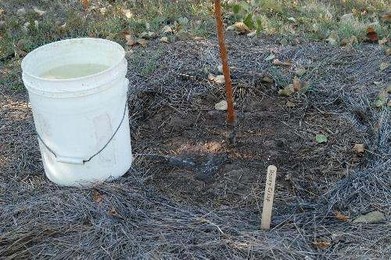
Rain saturated soils can damage root systems. Excess water drives oxygen out of the soil as pore spaces are filled with water. Every living cell in a plant must have oxygen to live. If there is no oxygen, roots will die.
Therefore, many of our plants may need to be babied through the summer, especially since it has turned so hot so quickly.
Newly planted trees are especially vulnerable as they have not established the extensive root system needed to absorb enough water during hot, dry, windy summers. Even trees two or three years old should receive special care even if the root system was not damaged by saturated soils.
Deep, infrequent watering and mulching can help trees become established. Newly transplanted trees need at least 10 gallons of water per week, and on sandy soils they will need that much applied twice a week. The secret is getting that water to soak deeply into the soil, so it evaporates more slowly and is available to the tree’s roots longer. One way to do this is to drill a small hole (1/8") in the side and near the bottom of a 5-gallon bucket and fill it with water. Let the water dribble out slowly next to the tree. Refill the bucket once, and you have applied 10 gallons. Very large transplanted trees and trees that were transplanted two to three years ago will require more water.
A perforated soaker hose is a great way to water larger trees, a newly established bed or a foundation planting. See the accompanying article for an inexpensive way to water trees.
In sunbaked soil, you may need to rough up the surface with a hoe or tiller to get water to infiltrate easily. It may be helpful to set the kitchen oven timer, so you remember to move the hose or shut off the faucet. If you are seeing surface runoff, reduce the flow.
Regardless of method used, soil should be wet at least 12 inches deep. Use a metal rod, wooden dowel, electric fence post or something similar to check depth. Dry soil is much harder to push through than wet. Record the time that was required to reach 12 inches and then use a time clock for any future waterings. (Ward Upham)
Contributors: Ward Upham, Extension Associate
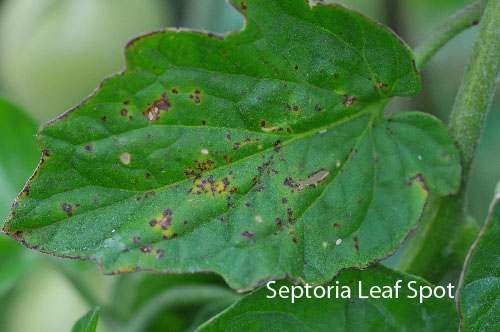
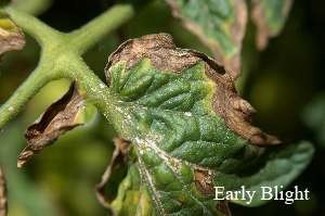
 RSS Feed
RSS Feed
